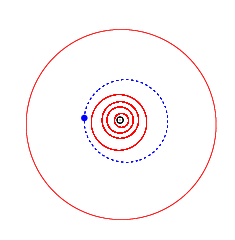9913 Humperdinck
|
| |||||||||||||
| Discovery | |||||||||||||
|---|---|---|---|---|---|---|---|---|---|---|---|---|---|
| Discovered by | C. J. van Houten, I. van Houten-Groeneveld & T. Gehrels | ||||||||||||
| Discovery date | 16 October 1977 | ||||||||||||
| Designations | |||||||||||||
| MPC designation | 9913 Humperdinck | ||||||||||||
Named after | Engelbert Humperdinck | ||||||||||||
| 4071 T-3, 1982 BA7, 1984 UU1 | |||||||||||||
| Orbital characteristics[1] | |||||||||||||
| Epoch 13 January 2016 (JD 2457400.5) | |||||||||||||
| Uncertainty parameter 0 | |||||||||||||
| Observation arc | 14025 days (38.40 yr) | ||||||||||||
| Aphelion | 2.6188728 AU (391.77779 Gm) | ||||||||||||
| Perihelion | 1.9558414 AU (292.58971 Gm) | ||||||||||||
| 2.2873571 AU (342.18375 Gm) | |||||||||||||
| Eccentricity | 0.1449339 | ||||||||||||
| 3.46 yr (1263.6 d) | |||||||||||||
| 331.86335° | |||||||||||||
| 0° 17m 5.665s / day | |||||||||||||
| Inclination | 4.974531° | ||||||||||||
| 62.579391° | |||||||||||||
| 18.512870° | |||||||||||||
| Earth MOID | 0.971618 AU (145.3520 Gm) | ||||||||||||
| Jupiter MOID | 2.61004 AU (390.456 Gm) | ||||||||||||
| Jupiter Tisserand parameter | 3.582 | ||||||||||||
| Physical characteristics | |||||||||||||
| |||||||||||||
| 15.1 | |||||||||||||
|
| |||||||||||||
9913 Humperdinck is a main belt asteroid. It orbits the Sun once every 3.46 years.[1] It is associated with the Flora family of asteroids.[2]
Discovered on October 16, 1977 by Cornelis Johannes van Houten and Ingrid van Houten-Groeneveld on archived photographic plates made by Tom Gehrels with the Samuel Oschin telescope at the Palomar Observatory, it was given the provisional designation "4071 T-3". It was later renamed "Humperdinck" after composer and music teacher Engelbert Humperdinck.[3]
References
- 1 2 "9913 Humperdinck (4071 T-3)". JPL Small-Body Database. NASA/Jet Propulsion Laboratory. Retrieved 13 April 2016.
- ↑ Zappalà, Vincenzo; Bendjoya, Philippe; Cellino, Alberto; Farinella, Paolo; Froeschlé, Claude (1997). "Asteroid Dynamical Families.". EAR-A-5-DDR-FAMILY-V4.1. NASA Planetary Data System.
- ↑ MPC 34356 Minor Planet Center
External links
This article is issued from Wikipedia - version of the 9/10/2016. The text is available under the Creative Commons Attribution/Share Alike but additional terms may apply for the media files.
